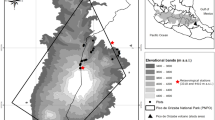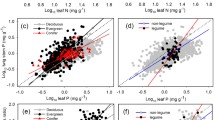Summary
Partitioning patterns in 22 exclusively low and 27 exclusively high altitude perennial herbaceous species were examined in order to test the hypothesis that plants of high altitudes allocate more dry matter to below-ground parts and in particular to storage organs, than typical low altitude plants. Our results raise some doubts about the general validity of this hypothesis. The mean fractions of total dry matter allocated to green leaves (22±2% s.e. at low and 24±2% at high altitude) and special storage organs (28±4% at both altitudes) do not differ significantly among sites. The mean relative portions of total dry matter allocated to above-ground plant parts amount to 57±3% at low and 42±3% at high elevation (P=0.002) and differ less than often assumed. The greater below-ground fraction at high altitude results from reduced stem and proportionally increased fine root compartments. At high altitude specific root length is increased by 50% and mean individual rooting density is tripled. Fine root length per unit leaf area is 4.5 times greater (P<0.001). However, interspecific variation in all these quantities is considerable and species with quite contrasting partitioning patterns coexist at both elevations. This suggests that the success of perennial herbaceous plants at high elevations does not necessarily depend on a large below ground biomass fraction. The increased fine root length at high altitude may substitute for reduced mycorrhizal infection. Figure 1 provides a graphical summary.
Similar content being viewed by others
References
Bierhuizen JF (1974) Root growth and its environment. Acta Hortic 39:127–140
Billings WD, Mooney HA (1968) The ecology of arctic and alpine plants. Biol Rev 43:481–529
Billings WD, Peterson KM, Shaver GR (1978) Growth, turnover, and respiration rates of roots and tillers in tundra graminoids. In: Tieszen LL (ed) Vegetation and production ecology of an Alaskan arctic tundra. Ecol Studies 29, Springer, New York Berlin Heidelberg, pp 415–434
Bliss LC (1971) Arctic and alpine plant life cycles. Ann Rev Ecol Systematics 2:405–438
Bloom AJ, Chapin FS III, Mooney HA (1985) Resource limitation in plants —an economic analogy. Ann Rev Ecol Syst 16:363–392
Böhm W (1979) Methods of studying root systems. In: Billings WD, Lange OL (eds) Ecological Studies 33, Springer, Berlin Heidelberg New York
Brouwer R (1983) Functional equilibrium: sense or nonsense? Neth J Agric Sci 31:335–348
Chapin III FS (1980) The mineral nutrition of wild plants. Ann Rev Ecol Syst 11:233–260
Corre WJ (1983) Growth and morphogenesis of sun and shade plants. III. The combined effects of light intensity and nutrient supply. Acta Bot Neerl 32:277–294
Goebel K (1913) Organographie der Pflanzen (1), 2nd ed, Fischer, Jena
Grabherr G, Mähr E, Reisigl H (1978) Nettoprimärproduktion und Reproduktion in einem Krummseggenrasen (Caricetum curvulae der Ötztaler Alpen, Tirol). Oecol Plant 13:227–251
Grime JP (1979) Plant strategies and vegetation processes. J Wiley & Sons, Chichester NY Brisbane Toronto, pp V-VI, 7–9, 20–75
Harley JL, Smith SE (1983) Mycorrhizal Symbiosis. Academic Press, London
Haselwandter K (1979) Mycorrhizal status of ericaceous plants in alpine and subalpine areas. New Phytol 83:427–431
Haselwandter K, Read DJ (1980) Fungal associations of roots of dominant and sub-dominant plants in high-alpine vegetation systems with special reference to mycorrhiza. Oecologia (berlin) 45:57–62
Haselwandter K, Hofmann A, Holzmann HP, Read DJ (1983) Availability of nitrogen and phosphorus in the nival zone of the Alps. Oecologia (Berlin) 57:266–269
Jackson LE, Bliss LC (1984) Phenology and water relations of three plant life forms in a dry tree-line meadow. Ecology 65:1302–1314
Karlsson PS (1985) Photosynthetic characteristics and leaf carbon economy of a deciduous and an evergreen dwarf shrub: Vaccinium uliginosum L. and V. vitis-idaea L. Holarctic Ecol 8:9–17
Kawano S, Masudo J (1980) The productive and reproductive biology of flowering plants. VII. Resource allocation and reproductive capacity in wild populations of Helonipsis orientalis. Oecologia (Berlin) 45:307–317
Kjelvik S, Kärenlampi L (1975) Plant biomass and primary production of fennoscandian subarctic and subalpine forests and of willow and heath ecosystems. In: Wielgolaski FE (ed) Fennoscandian tundra ecosystems. 1. Plants and microorganisms. Ecol Studies 16, Springer, Berlin, pp 111–120
Wielgolaski FE Bliss LC, Svoboda J, Doyle G (1981) Primary production of tundra. In: Bliss LC, Heal OW, Moore JJ (eds) tundra ecosystems: a comparative analysis. Cambridge University Press, Cambridge, pp 187–225
Woodward FI (1983) The significance of interspecific differences in specific leaf area to the growth of selected herbaceous species from different altitudes. New Phytol 95:313–323
Zachhuber K, Larcher W (1978) Energy contents of different alpine species of Saxifraga and Primula depending on their altitudinal distribution. Photosynthetica 12:436–439
Author information
Authors and Affiliations
Rights and permissions
About this article
Cite this article
Körner, C., Renhardt, U. Dry matter partitioning and root length/leaf area ratios in herbaceous perennial plants with diverse altitudinal distribution. Oecologia 74, 411–418 (1987). https://doi.org/10.1007/BF00378938
Received:
Issue Date:
DOI: https://doi.org/10.1007/BF00378938




